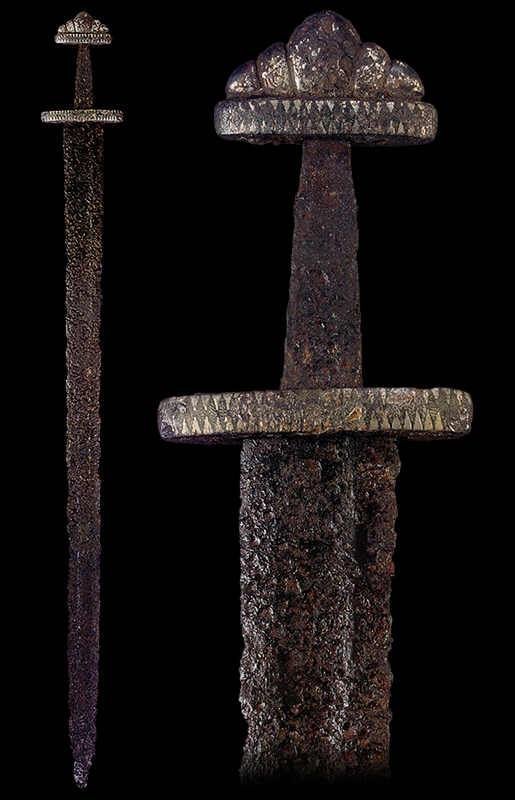With double-edged blade of gradual taper; inlaid on both sides in gold and silver with decorative patterns, one side bearing a gradually tapering geometric-architectural design in five stages and the other bearing a gradually tapering palmette design. The hilt comprising down-curved cross guard, sturdy tang and five-lobed pommel riveted to the upward-curving upper guard; the cross-guard, upper guard and pommel all inlaid in silver with decorative knotwork and tracery and in gold with dots.
Overall length: 94 cm (37"); Blade length: 80.6 cm (31.75")
This rare Viking sword, the hilt of Petersen Type O, has a cross-guard with decorative devices reminiscent of those on one of the three swords that were found in the rich ship burial of about 900 at Hedeby in Denmark when it was subsequently excavated in the 1950s. More of these ‘rabbit ear’ or ‘knotted rope’ characters may be found on three of the ‘Hiltipreht’ group of swords, namely one in the Wallace Collection, London (Inv. No. A456), the Ballinderry sword in the National Museum of Ireland, Dublin (Inv. No.1928.382) and the example from Malhus in the Trondheim Museum, Norway (Petersen, Abb.89).
The credentials of this prestigious weapon are further enhanced by the decoration upon the blade. On one side there is a palmette design of inlaid silver with traces of gold that is very similar to that on a fragmented blade from the River Bann in Ireland and illustrated in Bøe. This should be compared with the inlay on a sword from the Waal near Nijmegen (Oakeshott, Records of the Medieval Sword, p.47). On the other side, the inlaid precious metals may well represent a schematic plan view of a building, as is believed to have been intended upon another silver inlaid sword illustrated and described by Ewart Oakeshott (Records of the Medieval Sword, pp.28-29). This is certainly not a ceremonial weapon, as is indicated by the hefty tang, the robust blade and the array of battle nicks along the blade. To the Viking Warrior, his sword represented his very life and was among his most treasured possessions. The nature of this close and powerful partnership between warrior and weapon may best be demonstrated by an extract from an Estonian Viking Epic which asks,
“Who can separate a man from his sword? One is worth nothing without the other.”
Swords with sound reputations in battle and other fine qualities would be handed down from father to son and generation to generation. They could be looked upon as having a unique character and personality of their own and many were deemed to possess even magical qualities. The Norse Sagas record notable numbers of swords that were ancient heirlooms, either extracted from burial-mounds of dead warriors for further use or family weapons literally handed down for generations. Swords committed to the ground, sometimes for more than a century, would have required some degree of protection and may well have received a coating of animal fat before being wrapped in sheepskin, where the naturally occurring lanolin would protect against corrosion.
In Norse literature, especially in the vast body of Skaldic poetry, swords (as well as byrnies, axes and spears) are given striking and evocative names, called Kennings (meaning the name by which they were known, or “kenned”). Kennings such as: ‘Byrnie-Biter’, ‘'Leg-Biter’, ‘Viper’, ‘War Snake’, ‘Keen’, ‘Long and Sharp’, ‘Serpent of Blood’, ‘Odin’s Flame’, ‘Widow Maker’, ‘Ice of Battle’ are recorded. There were many reasons why a sword was named and therefore regarded as special. It could be the presence of a decorated hilt or of inlaid devices upon the blade, the excellent balance of the weapon in the hand or simply the sword's reputation as being sturdy, reliable and effective. The quality of our sword coupled with its fine decoration mean that we can be certain that during its active life it possessed these enhancing features and that it would undoubtedly have been named.
Literature:
From Viking to Crusader, (Exhibition Catalogue, Copenhagen, 1992), entry 171
Oakeshott, R.E. and Peirce, I. G., ‘Hiltipreht! Name or Invocation’, in Park Lane Arms Fair Catalogue, No. 12 (1995), pp. 6-11
Bøe, J., Norse Antiquities in Ireland (Oslo, 1940), pp. 83-85. Davidson, H.R. Ellis, The Sword in Anglo-Saxon England (Woodbridge, Suffolk), 1994
Petersen, J., De Norske Vikingesverd (Oslo, 1919)
Copyright © Peter Finer

An Exceptional Viking Sword with Gold and Silver Inlaid Blade and Hilt, early 10th century
